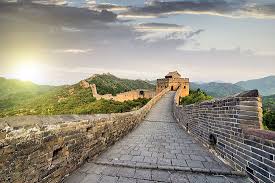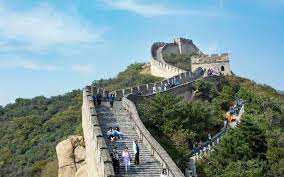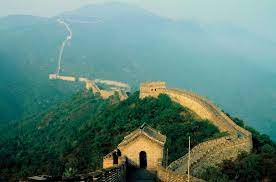The Great Wall of China stands as a testament to human ingenuity, determination, and the enduring spirit of a civilization that spans millennia. Stretching over 13,000 miles, it winds its way through China’s vast landscapes, spanning deserts, grasslands, mountains, and plateaus. As one of the most iconic and enduring symbols of Chinese civilization, the Great Wall continues to captivate the imagination of people around the world.
Click here to see a video: https://www.britannica.com/video/179589/Overview-Great-Wall-of-China
A Monumental Feat of Engineering
Constructed over several centuries, the Great Wall is not a single continuous structure but rather a series of walls, fortifications,
and natural barriers built and rebuilt by various Chinese dynasties. The earliest sections date back to the 7th century BC, while the
most well-known sections were built during the Ming Dynasty (1368-1644 AD).
The construction of the Great Wall played a crucial role in unifying various Chinese states and kingdoms into a single empire. It
symbolizes the unity and strength of the Chinese nation, as successive dynasties worked together to fortify and expand this monumental structure. The Great Wall remains a powerful symbol of national identity, evoking pride and patriotism among the Chinese people.
The engineering marvel of the Great Wall is awe-inspiring. It incorporates a variety of construction techniques, including rammed earth, brick, stone, and wood. Towers, watchtowers, and fortresses dot its length, providing strategic vantage points for defense and communication.


Historical Significance
Beyond its architectural grandeur, the Great Wall holds immense historical significance. Originally built to protect China from
invading nomadic tribes from the north, it served as a vital line of defense, safeguarding the country’s borders and preserving its
cultural heritage.
The Great Wall also played a crucial role in facilitating trade, communication, and cultural exchange along the ancient Silk Road.
It served as a conduit for goods, ideas, and technologies between China and the West, shaping the course of history in the process.
Architectural Diversity and Innovation
One of the remarkable aspects of the Great Wall is its architectural diversity and innovation. As it spans diverse landscapes
and terrains, from rugged mountains to vast plains, different sections of the wall exhibit varying construction techniques and materials. Some sections feature massive stone blocks meticulously fitted together, while others utilize rammed earth and brickwork.
The architectural ingenuity of the Great Wall reflects the adaptability and resourcefulness of the builders who constructed it.
Cultural Legacy and UNESCO World Heritage Site
Today, the Great Wall stands as a symbol of Chinese resilience, unity, and cultural identity. It embodies the enduring legacy of
a civilization that has withstood the test of time and continues to inspire admiration and reverence.
In 1987, UNESCO designated the Great Wall of China as a World Heritage Site, recognizing its outstanding universal value and cultural significance. It remains one of the most visited tourist attractions in the world, attracting millions of visitors each year who come to
marvel at its splendor and immerse themselves in its rich history.
Preserving a Global Treasure
While the Great Wall has endured for centuries, it faces numerous challenges, including erosion, weathering, and human encroachment. Efforts to preserve and protect this global treasure are ongoing, with restoration projects and conservation initiatives underway to ensure that future generations can continue to experience its majesty.
Myth and Legend
The Great Wall has inspired numerous myths, legends, and folklore throughout history. Tales of valiant warriors, epic battles,
and supernatural creatures are woven into the fabric of Chinese folklore, adding to the mystique and allure of the Great Wall.
These stories have been passed down through generations, enriching the cultural tapestry of China and captivating the imaginations
of people worldwide.
Modern Significance and Tourism
In the modern era, the Great Wall has become a symbol of China’s economic and cultural resurgence. It serves as a major tourist
attraction, drawing visitors from all corners of the globe to marvel at its sheer scale and historical significance. Tourism provides
vital revenue for local communities and contributes to the preservation and maintenance of the Great Wall.
Challenges and Conservation Efforts
Despite its enduring legacy, the Great Wall faces numerous challenges, including environmental degradation, urbanization, and tourism-related pressures. Conservation efforts are underway to address these challenges and ensure the long-term preservation of this iconic monument. These efforts involve collaboration between government agencies, conservation organizations, and local communities to balance the need for tourism with the imperative of protecting the Great Wall for future generations.
The Great Wall of China is more than just a physical barrier; it is a living testament to the human spirit and the enduring legacy of one of the world’s oldest civilizations. Its grandeur, historical significance, and cultural legacy continue to inspire wonder and admiration, making it a symbol of pride for the Chinese people and a marvel for the world to behold. As we marvel at its splendor, let us also commit to preserving and protecting this global treasure for generations to come.
Read More: https://placesandlifestyle.com/yankari-game-reserve-a-safari-adventure-in-nigeria/




